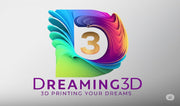In recent years, two innovative technologies have been making waves across multiple industries: 3D printing and haptics. While each has its own unique set of applications and advantages, the intersection of these two technologies is beginning to reveal groundbreaking possibilities. From enhancing product design to creating more immersive virtual experiences, the convergence of 3D printing and haptics is set to revolutionize how we interact with the world around us.
Understanding 3D Printing and Haptics
3D Printing: Also known as additive manufacturing, 3D printing involves creating three-dimensional objects layer by layer from digital models. This technology has democratized manufacturing, allowing for rapid prototyping, customization, and production across industries such as healthcare, automotive, aerospace, and consumer goods.
Haptics: Haptic technology involves creating tactile sensations through force, vibrations, or motions, allowing users to "feel" virtual objects. It's widely used in applications like virtual reality (VR), gaming, and mobile devices, enhancing user interaction by providing sensory feedback that mimics real-world touch and manipulation.
The Synergy of 3D Printing and Haptics
1. Enhanced Prototyping and Product Design:
- Rapid Iteration: 3D printing enables designers to quickly produce physical prototypes, while haptic feedback allows them to interact with these prototypes in a more intuitive and realistic way. This combination accelerates the design process and improves the accuracy of the final product.
- Tactile Feedback in Design: By integrating haptic feedback into the design process, engineers and designers can assess the texture, flexibility, and ergonomics of a product before it goes into production, leading to better user-centered designs.
2.Medical and Healthcare Applications:
- Surgical Training: 3D printed models of organs and tissues can be used in conjunction with haptic devices to create realistic surgical simulators. These simulators provide tactile feedback, helping surgeons practice and refine their techniques in a risk-free environment.
- **Prosthetics:** Customized 3D printed prosthetics can be enhanced with haptic feedback to give users a sense of touch, improving the functionality and acceptance of prosthetic limbs.
3. Education and Research:
- Interactive Learning: 3D printed models combined with haptic technology can transform education by providing hands-on learning experiences. For instance, students can explore the intricacies of human anatomy or mechanical systems with a tactile component that enhances understanding.
- Scientific Research: Researchers can use these technologies to create detailed physical models of molecular structures or geological formations, allowing for a more interactive and tactile exploration of complex subjects.
4. Immersive Virtual Experiences:
- VR and AR: In virtual and augmented reality, 3D printed objects paired with haptic feedback devices can create a more immersive experience. Users can not only see and hear their virtual environment but also feel it, leading to more realistic simulations and gaming experiences.
- **Remote Interaction:** Haptic technology can enable remote interactions with 3D printed objects, allowing users to manipulate objects from a distance with precise tactile feedback, which could be useful in fields like remote surgery or robotic exploration.
Future Prospects
The future of 3D printing and haptics holds immense potential. As these technologies continue to evolve, we can expect to see:
-Increased Integration: More seamless integration of haptic feedback in 3D printing processes, enhancing the user experience in both design and end-use applications.
- Advanced Materials: Development of new materials that can mimic the tactile properties of real-world objects more accurately, further bridging the gap between virtual and physical worlds.
- Accessibility and Affordability: As these technologies become more accessible and affordable, a wider range of industries and consumers will be able to leverage their benefits, leading to a surge in innovation and application diversity.
In conclusion, the convergence of 3D printing and haptics is set to redefine the boundaries of design, interaction, and experience. By bringing together the tangible and the tactile, these technologies are opening up new horizons in how we create, learn, and interact with our environment. As we move forward, the fusion of 3D printing and haptics will undoubtedly continue to unlock new possibilities, transforming our digital and physical landscapes in profound ways.
